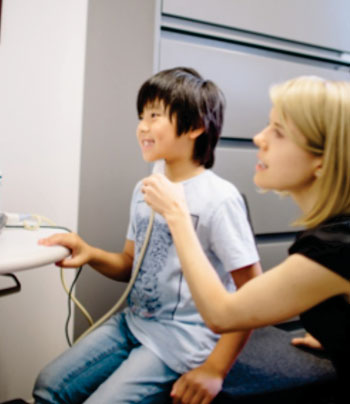Ultrasound Used to Help Children with Speech Problems
By MedImaging International staff writers
Posted on 17 Nov 2014
Ultrasound technology is being used to visualize the tongue’s shape and movement, and can help children with difficulty pronouncing “r” sounds, according to a small study. The ultrasound intervention was effective when children were allowed to make different shapes with their tongue in order to produce the “r” sound, instead of being instructed to make a specific shape.Posted on 17 Nov 2014
The findings were published online October 2014 in the Journal of Speech, Language, and Hearing Research. The “r” sound is one of the most frequent speech errors, and can be challenging to correct. For other sounds, such as “t” or “p,” speech pathologists can give clear verbal, visual, or tactile cues to help children understand how the sound is created. “R” is difficult to show or describe in an easy-to-understand fashion. Moreover, most speech sounds are produced in the same way, but with “r,” normal speakers use widely different tongue shapes to create the sound. The two basic strategies to create the “r” sound include a retroflex tongue shape, where the tongue tip is pointed up, and the bunched tongue shape, where the tongue tip is pointed down and body of tongue bunches up toward the top of the mouth.

Image: Using ultrasound technology to visualize the tongue’s shape and movement can help children with difficulty pronouncing “r” sounds, according to research led by NYU Steinhardt assistant professor Tara McAllister Byun (Photo courtesy of Ramsay de Give/NYU Steinhardt).
Up to 10% of children have speech sound disorders, in the United States, according to the US National Institutes of Health (Bethesda, MD, USA). Some children respond well to standard forms of speech therapy, but others have errors that persist in spite their therapists’ best efforts. An increasing body of evidence suggests that treatment incorporating visual biofeedback, which uses various technologies to create a dynamic visual representation of speech, could fill this need.
“The idea that you could get around the challenges with ‘r’ sounds by showing children their tongues as they are talking is really appealing to clinicians,” said Tara McAllister Byun, an assistant professor in New York University’s (NYU) Steinhardt School of Culture, Education, and Human Development’s (New York, NY, USA) department of Communicative Sciences and Disorders, and the study’s lead author. “That’s what ultrasound technology lets us do.”
Linguists have used ultrasound to examine the fundamental functions of speech, and in recently, speech pathologists have begun studying using ultrasound to treat children with speech problems. An ultrasound probe—similar to ones used in cardiac and tissue imaging—is held under the chin, and sound waves capture real-time images of the tongue. The images provide both the child and speech pathologist with information about the tongue’s position and shape.
Using the ultrasound images as a guide, children learn how to manipulate their tongues, and speech pathologists advise them on how to make adjustments to better achieve different sounds. Several case studies and small studies suggest that ultrasound biofeedback can effectively correct “r” speech errors. Dr. Byun and her colleagues’ goal was to gather systematic evidence on the effectiveness of the treatment, studying eight children with difficulty pronouncing “r” sounds. Seven of the eight had earlier speech therapy that was unsuccessful.
Four children participated in the initial eight-week study. They were taught to make a bunched tongue shape, guided by ultrasound, in an effort to better pronounce “r.” The researchers saw only small improvements among the four participants. However, while trying to create a bunched tongue, one child stumbled upon a retroflex tongue shape and was able to improve her “r” sound. As a result of her success, the researchers changed their study design to allow participants to choose their own tongue shape, with individualized guidance from speech language pathologists.
A different four children participated in the second study over an eight-week period. Using ultrasound to visualize their tongues, all four participants in the second study revealed substantial improvement in their “r” sounds. “Our second study offers evidence that when flexibility is given to choose a tongue shape, rather than a one-size-fits all approach, ultrasound biofeedback treatment can be a highly effective intervention for children with trouble pronouncing ‘r’ sounds,” Dr. Byun stated.
The researchers noted that the two studies were not a controlled comparison, therefore, further systematic research is needed before drawing strong conclusions about the importance of individualized tongue shapes.
Related Links:
New York University’s Steinhardt School of Culture, Education, and Human Development













.jpg)
